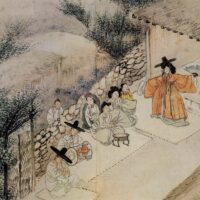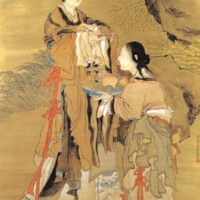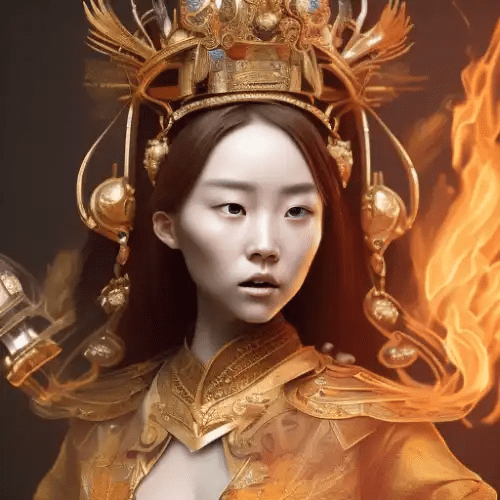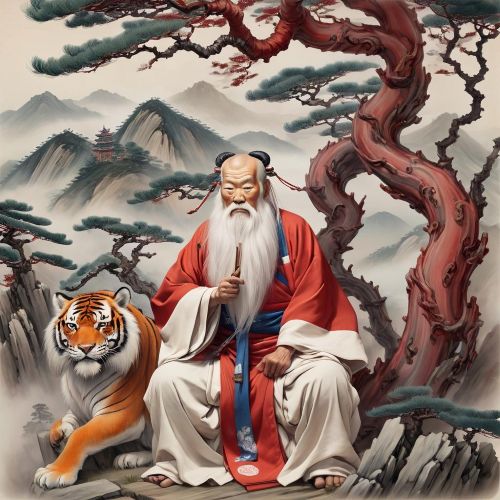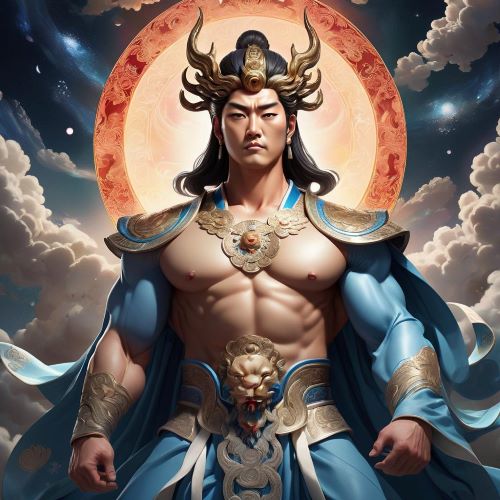Samsin Halmeoni : Goddess of Childbirth
Listen
At a glance
| Description | |
|---|---|
| Origin | Korean Mythology |
| Classification | Gods |
| Family Members | Tanggum Aeggi (Mother) |
| Region | Korea |
| Associated With | Childbirth, Fate, Creation |
Samsin Halmeoni
Introduction
Samsin Halmeoni, also known as Samshin Halmoni, holds a revered place in Korean mythology as the goddess of childbirth, fate, and the protector of young children. She represents the divine maternal force responsible for ushering new life into the world and ensuring the well-being of infants and mothers. Deeply embedded in Korea’s folk religion and shamanistic practices, her worship dates back to antiquity and continues to shape cultural traditions today. Samsin Halmeoni isn’t just a mythological figure—she’s a powerful archetype of protection, wisdom, and the enduring role of maternal care in Korean society.
Physical Traits
In traditional beliefs, Samsin Halmeoni is visualized as a wise elderly woman, embodying both gentleness and spiritual authority. Often dressed in a hanbok, her appearance reflects a dignified grandmotherly figure whose presence exudes comfort and stability. She is frequently envisioned within the anbang, the innermost room of a Korean home, which serves as a sacred space for rituals in her honor. Some interpretations depict her in multiple forms—either as three distinct old women representing a triune aspect of life or appearing in everyday disguises to test a family’s compassion and devotion. These diverse manifestations add a mystical layer to her mythology, reinforcing her omnipresence in both divine and mundane realms.
Family
According to Korean oral traditions, Samsin Halmeoni is the daughter of the virgin sky goddess known as Tanggum Aeggi, the original mudang or shamaness. This celestial lineage situates her firmly within the cosmology of Korean shamanism. Born in a cave—a potent symbol associated with the womb and the natural world—she is often tied to ancient bear worship traditions that predate organized religion in Korea. As the mother of the Samsin triplets, she becomes the life-giving force responsible for human genesis, anchoring her role as the maternal origin of all people. In some Buddhist-influenced retellings, her myth expands to include divine sons who ascend to celestial ranks, further deepening her mythological roots.
Other names
Samsin Halmeoni is known by several names, each reflecting a different aspect of her divine identity and regional interpretation. The term “Samsin” itself denotes the “three spirits” or “three gods,” symbolizing the triadic nature of her influence. The word “Halmeoni,” meaning grandmother, adds a layer of respect and familial closeness to her title. In Jeju Island, she is referred to as Samseunghalmang, portraying her more as an individual rather than a trio. Other variations like Samsin Agissi—a youthful form mentioned in some folktales—highlight her dynamic representation across generational and mythological spectrums. These differing names underscore her widespread recognition and spiritual adaptability throughout Korean culture.
Powers and Abilities
The divine powers of Samsin Halmeoni are intrinsically tied to the cycle of life. She governs conception, ensures safe childbirth, and protects newborns through their most vulnerable years, especially the culturally significant first 100 days after birth. Her reach extends until a child turns seven, at which point other guardian deities are believed to take over. She is said to influence the destiny of each child from birth, a power symbolically linked to mythical places like the Seocheon Flower Garden, where blooming flowers determine fate. Samsin Halmeoni is also believed to inhabit the Samsin Danji, an earthenware jar filled with sacred offerings such as rice or water, representing her spiritual presence in the household. Her blessings promote fertility, good health, and harmonious family life, while neglecting her rituals could bring misfortune or illness—emphasizing her dual role as both protector and enforcer of moral duty.
Modern Day Influence
Although the prominence of shamanistic rituals has declined in urban Korea, Samsin Halmeoni continues to influence Korean culture in nuanced ways. Many families, especially in rural areas, still observe traditions such as preparing a Samshin Sang—a table of offerings set up during childbirth and other family ceremonies. Even in modern hospitals, mothers might quietly offer thanks to Samsin Halmeoni for a safe delivery. The symbolic weight of her figure persists in contemporary conversations around motherhood, reproductive health, and women’s spiritual roles in Korean society.
Her presence has also been reimagined in modern media. Korean dramas like Mystic Pop-up Bar and Goblin feature characters inspired by Samsin Halmeoni, portraying her as a wise, magical elder who guides human destiny. These representations maintain her core attributes—protection, wisdom, and maternal intuition—while bringing her into the realm of popular culture. In everyday language, fertility specialists are sometimes humorously called “Samsin Halmeoni,” illustrating her continued role as a metaphor for successful childbirth.
Spiritual practices have evolved as well, with personalized altars and mental rituals taking the place of formal shamanic ceremonies. For those who embrace a hybrid spiritual path, Samsin Halmeoni is honored through private acts of remembrance, storytelling, and ancestral connection. She is also a recurring figure in feminist reinterpretations of Korean mythology, celebrated as a divine embodiment of female power and resilience.
Related Images
Source
Monaghan, P. (2014). Encyclopedia of Goddesses and Heroines. New World Library. https://www.newworldlibrary.com/Products/9781608682171/encyclopedia-of-goddesses-and-heroines.aspx
Pentikäinen, J. (1996). Shamanism and Northern Ecology. Walter de Gruyter. https://www.degruyter.com/document/doi/10.1515/9783110816624/html
Wikipedia contributors. (2024, February 28). Samsin Halmeoni. Wikipedia. https://en.wikipedia.org/wiki/Samsin_Halmeoni
NamuWiki contributors. (2025). Samshin Halmi. NamuWiki. https://en.namu.wiki/w/%EC%82%BC%EC%8B%A0%ED%95%A0%EB%AF%B8
Wattpad. (n.d.). Korean Mythology – Samshin Halmoni. Wattpad. https://www.wattpad.com/723272033-korean-mythology-samshin-halmoni
Lingua Asia. (2024, January 10). Korean Mythology, Gods, and Goddesses Explained by a Local. Lingua Asia. https://linguasia.com/korean-mythology-gods-goddesses
Mythology WorldWide. (2024). The Curse of the Samshin: Navigating the Powers of Korean Deities. Mythology WorldWide. https://mythologyworldwide.com/the-curse-of-the-samshin-navigating-the-powers-of-korean-deities/
Frequently Asked Questions
What is lorem Ipsum?
I am text block. Click edit button to change this text. Lorem ipsum dolor sit amet, consectetur adipiscing elit. Ut elit tellus, luctus nec ullamcorper mattis, pulvinar dapibus leo.
What is lorem Ipsum?
I am text block. Click edit button to change this text. Lorem ipsum dolor sit amet, consectetur adipiscing elit. Ut elit tellus, luctus nec ullamcorper mattis, pulvinar dapibus leo.
What is lorem Ipsum?
I am text block. Click edit button to change this text. Lorem ipsum dolor sit amet, consectetur adipiscing elit. Ut elit tellus, luctus nec ullamcorper mattis, pulvinar dapibus leo.
What is lorem Ipsum?
I am text block. Click edit button to change this text. Lorem ipsum dolor sit amet, consectetur adipiscing elit. Ut elit tellus, luctus nec ullamcorper mattis, pulvinar dapibus leo.
What is lorem Ipsum?
I am text block. Click edit button to change this text. Lorem ipsum dolor sit amet, consectetur adipiscing elit. Ut elit tellus, luctus nec ullamcorper mattis, pulvinar dapibus leo.



